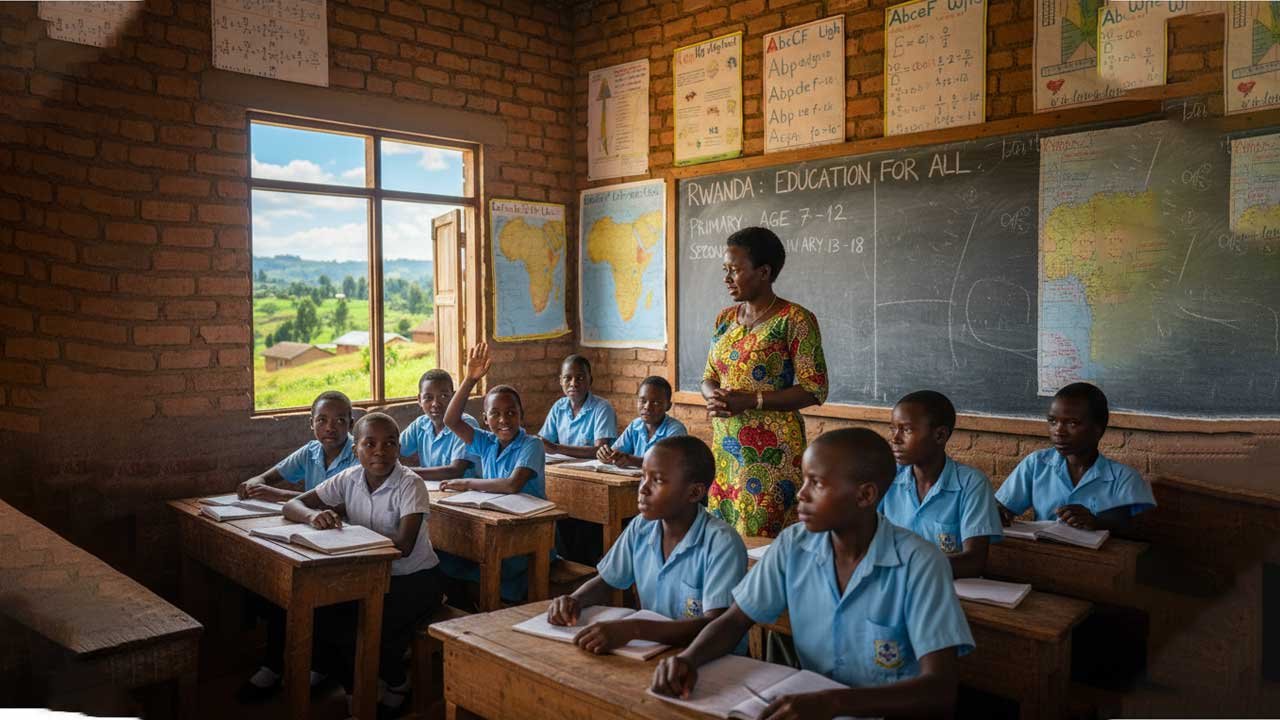Rwanda’s education system, structured as 3-6-3-3-4 (Pre-primary to University), reflects the country’s strong commitment to human capital under Vision 2050.
While access to primary education is nearly universal, with high enrollment rates, challenges persist in over-age enrollment, low completion rates at secondary levels, and disparities between urban and rural areas.
Pre-primary access remains limited, secondary attendance drops sharply after primary, and tertiary enrollment is still low, especially among women. Despite progress in literacy and gender parity, issues of quality, dropout rates, and learning outcomes continue to hinder Rwanda’s goal of becoming a knowledge-based economy.
| Aspect | Key Information |
|---|---|
| National Strategy | Education central to Vision 2050 for a knowledge-based economy |
| System Structure | 3-6-3-3-4 (Pre-Primary, Primary, Lower & Upper Secondary, University) |
| Compulsory Education | 9 years (Primary + Lower Secondary), generally ages 7–15 |
| Pre-Primary Enrollment | ~24.2% (2021/22); limited access, especially rural areas |
| Primary Attendance (Ages 7–12) | NAR: 89.3%; GAR: 141.7% → widespread over-age enrollment |
| Primary Completion | ~68–74% (higher for girls than boys) |
| Secondary Attendance (Ages 13–18) | 42% out of school; GER ~45.1% (2023) |
| Lower Secondary Completion | ~39% (2020) |
| Upper Secondary Completion | ~16.6% (2022); urban 27.8%, rural 11% |
| Tertiary Enrollment (Ages 19+) | GER: 8.89% (2023); GPI: 0.77 (female underrepresentation) |
| Adult Literacy (15+) | 78.8% overall; male 81%, female 76.7% |
| Urban–Rural Literacy Gap | Urban 89.8%, Rural 74.2% |
| Key Challenges | Over-age enrollment, dropouts, low secondary completion, poor learning quality, and rural disparities |
| Early Childhood Issues | 33% stunting rate affects school readiness and learning outcomes |
Age-Wise Education in Rwanda: Structure, Attainment, and Challenges
Rwanda has placed a strong emphasis on education as a core component of its national development strategy, Vision 2050, aiming to transform into a knowledge-based economy. The education system is structured to provide extensive basic education, although significant challenges related to completion, over-age enrollment, and quality persist.
The Structure of Rwandan Education by Age
The Rwandan education system largely follows a 3-6-3-3-4 structure (Pre-Primary – Primary – Lower Secondary – Upper Secondary – University). Nine years of basic education (Primary and Lower Secondary) are generally considered compulsory and free in public schools, though this has evolved over time.
| Education Level | Official Duration | Official Age Range |
| Pre-Primary (Nursery) | 3 years | Ages 3–5 |
| Primary (P1–P6) | 6 years | Ages 6 or 7–12 |
| Secondary – Lower (S1–S3) | 3 years | Ages 13–15 |
| Secondary – Upper (S4–S6) | 3 years | Ages 16–18 |
| Higher Education (University) | 3-4 years (Bachelor’s) | Ages 19+ |
Note: The official primary school entry age is often cited as 7 years, and the compulsory age range is typically 7 to 13 years, covering Primary and Lower Secondary.
Enrollment and Attendance by Age Group
Rwanda boasts one of the highest primary school enrollment rates in Africa, a major achievement. However, statistics reveal a substantial issue with students being over-age for their respective grades, often due to late entry, high repetition rates in the past, or temporary drop-out.
1. Pre-Primary Education (Ages 3-5) 👶
- Net Enrollment/Attendance Rate: This level has the lowest enrollment. The Net Enrolment Rate (NER) for pre-primary was approximately 24.2% in 2021/2022. UNICEF data also suggested only about 18% of children were enrolled in pre-primary education around 2019.
- Challenge: Access to formal pre-primary programs is limited, especially in rural areas, hindering school readiness for many children. The government aims to significantly expand access to this foundational level.
2. Primary Education (Official Ages 7-12) 🎒
Net Attendance Rate (NAR): High, around 89.3% nationally (2022 census), indicating that most children in the official primary age range are in school. Girls (90.3%) have a slightly higher NAR than boys (88.4%).
Gross Attendance Rate (GAR): Extremely high, at 141.7% (2022 census). The fact that the GAR is much higher than the NAR highlights the widespread issue of over-age attendance, where a significant number of children attending primary school are older than the official 7-12 age group.
Completion Rate: A persistent challenge is the transition and completion. The primary school completion rate for the relevant age group was approximately 67.26% in 2016, with girls (73.48%) outperforming boys (60.98%). More recent data (2020) suggests completion was at 68% for boys and 74% for girls.
3. Secondary Education (Official Ages 13-18) 🧑🎓
Out-of-School Youth: Nearly 42% of youth of secondary school age (13-18) were out of school (around 2015 data), indicating a major drop-off after the primary cycle.
Lower Secondary Completion (Ages 13-15): The total completion rate for lower secondary education was relatively low at 34.62% in 2016 (girls at 36.80% and boys at 32.43%). By 2020, completion rates remained low, estimated at 39% for both boys and girls.
Upper Secondary Completion (Ages 16-18): Completion rates for the upper secondary level are even lower. The national completion rate was around 16.6% (2022 census), with urban areas (27.8%) having significantly higher rates than rural areas (11.0%).
Gross Enrollment Rate (2023): The secondary school gross enrollment rate stood at approximately 45.13%, a substantial increase but still low compared to primary enrollment.
Educational Attainment and Literacy (Ages 15+)
Data on the educational attainment of the population demonstrates the historical and ongoing challenge in retaining students through the secondary level.
- Youth (Ages 15–24) Attainment (c. 2015 Data):
- No formal education: 3%
- Attained at most incomplete primary: 44%
- Completed primary: 15%
- Incomplete secondary: 31%
- Completed secondary: 6%
- Post-secondary: 1%
- Adult Literacy (Ages 15+): The overall literacy rate for the population aged 15 years and above was 78.8% in the 2022 census.
- Gender Disparity: Males have a higher literacy rate (81.0%) than females (76.7%).
- Urban-Rural Disparity: Urban areas have a significantly higher literacy rate (89.8%) compared to rural areas (74.2%).
Tertiary Education (Ages 19+)
Gross Enrollment Rate (GER): Enrollment in higher education remains low but is increasing. The tertiary school GER was 8.89% in 2023.
Gender Parity: The Gender Parity Index (GPI) for tertiary enrollment was 0.77 (2023), indicating that women are underrepresented in higher education compared to men.
Key Disparities and Challenges
While access to primary education has dramatically improved, the system faces several challenges:
- Age-Grade Mismatch: A high Gross Attendance Rate in primary school (141.7%) compared to the Net Attendance Rate (89.3%) underscores a significant problem with children starting school late or repeating grades, leading to a large population of over-age learners.
- Quality of Learning: High enrollment hasn’t always translated to high learning outcomes. The estimated Learning Poverty (the share of children unable to read and understand an age-appropriate text by age 10) for Sub-Saharan Africa is high, a challenge Rwanda is actively addressing.
- Completion and Drop-out: Substantial drop-out rates occur between primary and secondary school, and completion rates for secondary education remain low, particularly in rural areas and among the poorest quintiles.
- Stunting and Early Childhood Development: Chronic malnutrition (33% stunting rate for children aged 6-59 months) affects early childhood development, directly impacting school readiness and performance.
- Rural vs. Urban: Literacy and completion rates are consistently higher in urban areas compared to rural areas, highlighting a major geographic disparity in educational access and quality.
FAQs on Rwanda’s education system
What is the structure of Rwanda’s education system?
Rwanda follows a 3-6-3-3-4 structure: 3 years of pre-primary, 6 of primary, 3 of lower secondary, 3 of upper secondary, and 3–4 of university.
What is the compulsory education period in Rwanda?
Nine years of basic education (primary and lower secondary), typically covering ages 7–15, are compulsory and free in public schools.
What is the official school starting age in Rwanda?
Children officially start primary school at age 7, though many begin late.
What is the current pre-primary enrollment rate?
Pre-primary Net Enrollment Rate is around 24.2% (2021/22), with access especially limited in rural areas.
How high is primary school attendance in Rwanda?
The Net Attendance Rate for primary school is 89.3%, while the Gross Attendance Rate is 141.7%, indicating many over-age learners.
What causes over-age enrollment in Rwandan schools?
Late entry, repetition, and temporary dropouts contribute to over-age attendance in primary and secondary levels.
What is the primary school completion rate?
Completion rates range between 68–74%, with girls performing better than boys.
What percentage of Rwandan youth are out of secondary school?
About 42% of youth aged 13–18 are out of school, reflecting a sharp drop after primary education.
What is the secondary school gross enrollment rate?
The Gross Enrollment Rate for secondary education is approximately 45.1% as of 2023.
How many students complete lower secondary school?
Around 39% of students complete lower secondary education.
How many students complete upper secondary school?
Only about 16.6% complete upper secondary school, with rural areas lagging behind.
How does urban vs. rural education compare?
Urban areas have higher completion and literacy rates, while rural areas face access and resource challenges.
What is Rwanda’s tertiary education enrollment rate?
The tertiary Gross Enrollment Rate is about 8.89% (2023).
What is the gender gap in higher education?
The Gender Parity Index for tertiary education is 0.77, meaning women are underrepresented.
What is the adult literacy rate in Rwanda?
Overall literacy among adults (15+) is 78.8%, with males at 81% and females at 76.7%.
How does literacy differ between urban and rural populations?
Urban literacy stands at 89.8%, while rural literacy is lower at 74.2%.
What are the major challenges in Rwanda’s education system?
Key challenges include over-age enrollment, low secondary completion, high dropout rates, and disparities in quality and access.
What role does early childhood development play in education outcomes?
High child stunting rates (33%) negatively affect school readiness and learning performance.
How is Rwanda improving education quality?
The government is expanding pre-primary access, improving teacher training, and addressing learning poverty to enhance outcomes.
What is Vision 2050 in relation to education?
Vision 2050 aims to transform Rwanda into a knowledge-based economy, positioning education as a central driver of national development.



Leave a Reply
You must be logged in to post a comment.